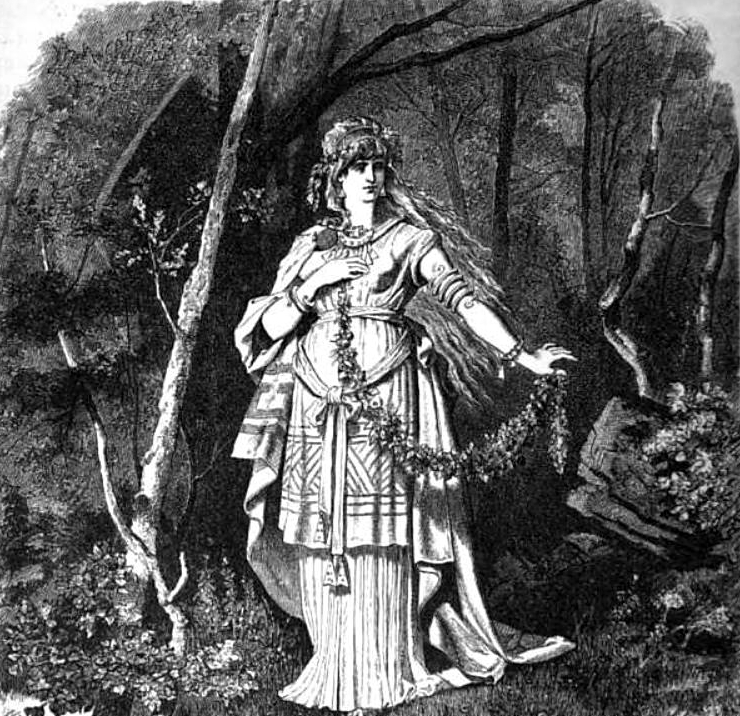In the Poetic Edda, Folkvang (Fólkvangr) is described as one of the many great halls in Asgard and is the home to fallen warriors chosen by Freyja.
Odin chooses half of the fallen Viking warriors and sends them to Valhalla, while Freyja chooses the other half and sends them to Folkvang.
Within the plains of Folkvang is the hall Sessrúmnir. Like Valhalla, Sessrúmnir is grand and beautiful, a fitting home for fallen Vikings in Norse mythology.
What is Folkvang?
We can understand Folkvang by studying the etymology of the word itself. Vanger, in Old Norse, translates to plain or meadow. Therefore, Folkvang is a green and beautiful place found within Asgard. It shares many similarities with Vahalla, except for its ruler.
Odin is the ruler of half the Vikings that fell in battle, while the goddess Freyja rules over the other half in Folkvang within the halls of Sessrúmnir.
Freyja, The Ruler of Folkvang
In popular culture, Freyja is often understood as a goddess of love and fertility, but she was much more than that. As described in the Grímnismál (Poetic Edda), Freyja is also a god of war and sometimes referenced as a Valkyrie.
In the Poetic Edda, Freyja is just as mighty and powerful as the god Odin. She receives half of the fallen warriors that ascend to Folkvang, while Odin takes the other half to Valhalla. Both the warriors of Valhalla and Folkvang train for the end of the world (Ragnarök).

What is Folkvang Like?
Unlike Vallhalla, there is little known about what Folkvang was like. Ancient poems and sagas pay fleeting references to Folkvang, but few surviving texts describe what Folkvang even looked like. We understand what Valhalla looked like, down to the roof made from shields. Those same descriptions are not provided for Folkvang.
Some scholars suggest that since Sessrúmnir is both the name of the hall in Folkvang and a ship referenced in the Skáldskaparmál (Prose Edda), the hall in Folkvang may perhaps be shaped like a ship.
However, given so many similarities between Valhalla and Folkvang, one could assume that these two afterlife training grounds were similar in splendor.
Folkvang Attestations in Norse Literature
There is very little known about Folkvang, and we can only make a few assumptions using the word’s etymology, and its references in the Poetic Edda and Prose Edda.
Poetic Edda
In the poem Grímnismál in the Poetic Edda, Odin references Folkvang as Freyja’s hall. He tells Agnar, the brother of Gerriod, that Freyja is the ruler of Folkvang.
Here, within the Poetic Edda, we learn that Odin takes half of the slain Viking warriors, and Freyja takes the other half.
Prose Edda
The Prose Edda, by Snorri Sturluson, dives deeper into the description of Folkvang. In the Gylfaginning, High takes a moment to describe the goddess Freyja.
He says that she is the most Ásynjur goddess that presides over all of Folkvang within the halls of Sessrúmnir.
What’s the Difference between Valhalla and Folkvang?
Folkvang and Valhalla are often compared to one another, and rightfully so. They are both homes for Vikings killed in battle and are both beautiful and grand. The only real difference between the two halls in Asgard is their rulers. The fallen Vikings are split right down the middle, and half go with Freyja, while the other half go with Odin.
When comparing these two places in the afterlife, there is no hierarchy of skills. One is not better than the other.
It’s important to note, however, that some scholars feel that Folkvang and Valhalla are the same places.
Check my detailed article on Folkvang Vs. Valhalla.
The Viking Afterlife
In Norse mythology, the Germanic people had three options to go when they died. Slain warriors were chosen by Odin and Freyja and gained entrance to Valhalla or Folkvang. But what about everyone else?
If you weren’t one of the lucky Vikings to train under Odin or Freyja for Ragnarök, you spent your afterlife in Hel. Hel isn’t as idyllic as feasting with Odin, but it isn’t the dark and scary modern interpretation of Hell.
